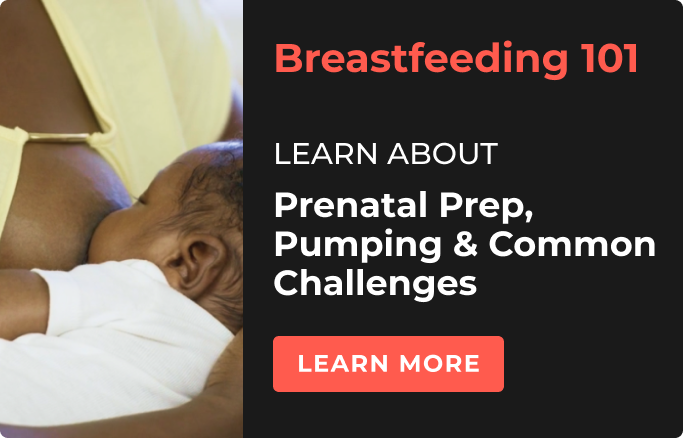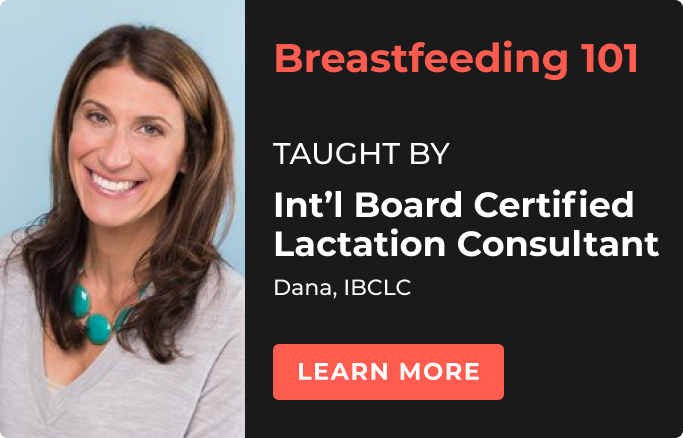If you’re worried about producing enough breast milk for your baby, you’re not alone. This is a common concern among breastfeeding parents at some point in their breastfeeding journey. In all likelihood, your body can produce enough milk. You just need to help it along a bit. How?
We asked our expert and certified lactation consultant Dana for her top tips for increasing breast milk production. Here are her recommendations.
1. Empty your breasts
Milk production is commonly described as a "supply and demand" process. But really, it's "demand and supply." What I mean by this is that the first step to getting more breast milk out of your body is to make your body aware that it needs to produce more breast milk.
Nursing or pumping frequently is important because it sends a message to your body that you need more. For most breastfeeding moms and parents, this means either nursing or pumping every two to three hours. But it’s not just about frequency; you also need to empty your breasts more effectively.
Here's the bottom line: when our breasts are full we have slower milk production; when our breasts are empty we have faster milk production.
So how do we effectively empty our breasts?
Address latch issues
Sometimes, your baby can be latched and "nursing" but not actually drinking. For example, they may be suckling at the breast but not actually removing any milk. This can be due to issues such as a shallow latch, a sleepy baby, or even an anatomical issue like a tongue tie. If your baby isn’t drinking, address the underlying cause. A board certified lactation consultant can help you and your baby achieve a deep, good latch, which in turn will help your baby remove milk, drain your breasts better, and ultimately, this will help increase your milk supply too.
Use your hands
You can also help your baby drain your breasts by using a gentle breast massage or a breast compression to squeeze the colostrum or milk into your baby's mouth. This goes for the breast pump, too—it doesn’t always get every last drop. Try using a gentle breast massage while pumping. In fact, research shows when we use our hands during a pumping session, our milk production increases. You can also try hand expressing for a few minutes after your pump stops extracting milk to make sure you are completely emptying your breasts. The more milk you remove, the more milk your body makes.
2. Step away from the app
Don't obsess over timing your feeds. Just because your app says you may be done feeding, it doesn't mean your baby is finished. Follow your baby's cues and allow them to breastfeed as long as they want. When we cut our babies off because our apps say it’s time, we could be sabotaging our milk production. You may hear the recommendation to feed ten minutes per side, but that’s an arbitrary number, and usually not enough time, so let your baby lead the way.
3. Use both breasts
After your baby nurses and drains one breast, offer the second one—even if you think they're done. Often with increased milk flow from the full side, the baby will become active again on the second side. If baby has fed on both sides and is still hungry, try going back to the first side for a final top off.
4. Hydrate
You don't need to go overboard here, but properly hydrating yourself is important. Drink enough to quench your thirst. Hydrate throughout the day, and make sure you have a glass of water nearby when you start to nurse or pump. Keep an eye on your urine—if it's very concentrated (dark yellow in color and/or has a strong odor), that’s a sign you need to hydrate.
5. Look into supplements
Many parents believe that making lactation cookies with oats, brewer's yeast, and flaxseed meal can help boost your supply. The research isn't solid on this, but it can’t hurt. Bonus: they’re delicious!
Additionally, some doctors and lactation consultants will recommend herbal supplements to help boost your supply. Anecdotally, many moms report success with taking herbal remedies. Please remember that when considering a new herbal supplement or medication, you should check with your healthcare provider about any side effects, contraindications, or drug interactions.
If you want more tips & tricks to increase your breast milk supply, Tinyhood can help. Our Breastfeeding 101 course covers the common causes and signs of low milk supply, strategies to boost supply, demonstrations of a good breastfeeding latch, and more.
About the Author
Dana C. is a professionally trained IBCLC (International Board Certified Lactation Consultant), who has earned the highest credentials one can pursue in lactation consulting and works at a top-ranked hospital where she has helped thousands of families. She is ivy-league educated with a master’s degree in public health, is a mom of two kids (and two dogs), and enjoys tending to her vegetable garden.




